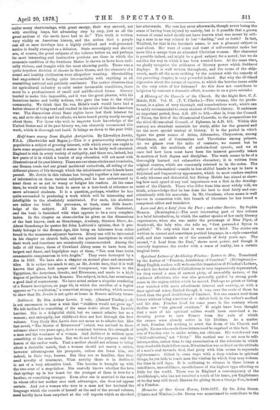Half-hours among Some English Antiquities. By Llewellyn Jewitt, (Hardwicke and
Bogue.)—This is a praiseworthy attempt to popularise a subject of growing interest, with which every one ought to have some acquaintance, and it seems to us to be fairly well executed. .England is rich in every variety of antiquity, and there are, indeed, but few parts of it in which a tourist of any education will not meet with illustrations of its past history. There are our stone-circles and cromlechs, our Roman roads and our grand medireval cathedrals, all telling of the different phases of life through which the inhabitants of our Islands have passed. Mr. Jewitt in this volume has brought together a fair amount of information on these various subjects, and he has endeavoured to treat them so as not to weary or fatigue his readers. At the same time, he would wish his book to serve as a text-book of reference to more advanced students. It is a question, perhaps, whether ho has quite succeeded in producing a work which will be interesting and intelligible to the absolutely uninitiated. For such, his sketches -are rather too brief. He presumes, at least, some little know- ledge of the subject. All his descriptions are illustrated, and the book is furnished with what appears to be a very complete index. In the chapter on stone-circles he gives us the dimensions of the best known, such as Stonehenge, Avebury, Stanton Drew, itc. About Stonehenge he quotes Sir John Lubbock's opinion, that it pro- bably belongs to the Bronze Age, this being an inference from relics found in the numerous adjaoent barrows. Every one will be interested in his chapter on church bells, and the quaint inscriptions in which their work and functions are occasionally commemorated. Among the bells of old times, those of Crowland Abbey seem to have been the largest and finest, and Ingulphus says of them, "Nee erat tunc tanta oonsonantia campanarum in tota Anglia." They were destroyed by a fire in 1091. We have also a chapter on stained glass and encaustic tiles. It is rather too much to say, as Mr. Jewitt does, that it is well known that glass, both opaque and transparent, was known to the Egyptians, the Assyrians, Greeks, and Etruscans, and made to a high degree of perfection by the Romans. The subject, in fact, has occasioned a good deal of controversy. We have noted rather a singular rendering of a Roman insmiption, on page 65, in which the vexillum of a legion appears as "a vexillation," a somewhat strange rendering, which seems to show that Mr. Jewitt is not quite at home in Roman military terms.


































 Previous page
Previous page